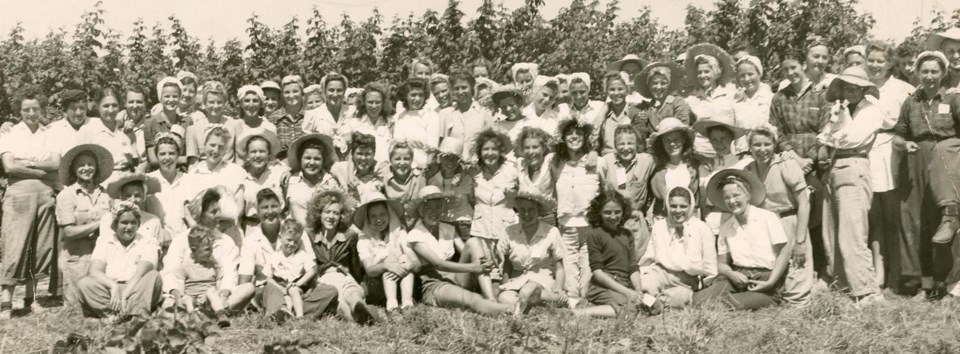It’s prime blueberry season in Richmond now, but the city and its first inhabitants, the First Nations, have a long history foraging and cultivating a wide variety of berries.
Richmond is renowned today for its cranberries and blueberries– but the blueberry was apparently the most popular berry on Lulu Island already in the late 1800s.
There appeared to be two types of blueberries in the early 1900s – tiny tart ones that grew in bunches, and larger ones that grew as single berries and were better in desserts.
But it was only one of a dozen berries found in what would later be called the Township of Richmond.
A historical researcher, Dellis Cleland, spoke to more than a hundred people in 1972 to ask them about their memories of berry picking in Richmond.
The report “Berrying in Richmond – Pleasure or Profit” can be found in the City of Richmond’s Archives.
Loganberries have fallen off the popular radar, but in the early 1900s, they were a highly sought-after berry.
But when the depression hit in the 1930s, the price of loganberries hit rock bottom – one cent a pound – so two Richmondites set about making wine from the then cheap but popular berry.
Loganberry wine made in Richmond was shipped as far away as Saskatchewan.
McKinney’s winery, located at No. 2 Road and Steveston Highway, made Martina Wine. They stored about 100,000 gallons at the winery in barrels bought from Sweeney’s Cooperage, located under the Cambie Street Bridge.
George W. Rathburn also established a winery at the same time, drawing on his own 40 acres of loganberries on Blundell Road between St. Albans and Garden City Road. Rathburn sold his wine locally, bringing customers in from Vancouver.
In addition to loganberries and blueberries, there were cranberries, huckleberries, salmonberries, three kinds of currants – black, red and white – strawberries and raspberries.
Berries were picked by Indigenous people as well as European and Chinese settlers.
Some Richmond residents recalled, as told to Cleland, Indigenous people coming along the Fraser River in canoes to pick berries. They would then trade them with settlers for clothing.
Other people interviewed by Cleland recalled Chinese berry pickers, wearing straw hats, walking down Garden City Road with twin baskets “weighted over their shoulders” full of berries.
Bog fires were blamed on these Chinese pickers, but there was no evidence of fires being deliberately set. In fact, fires were believed to “ensure a renewed crop of berries the next year,” Cleland notes.
The Chinese also used blueberries to make dye, according to interviewees.
During the Second World War, students who worked as berry pickers were paid four to six cents a pound.
Strawberries were grown in Richmond’s “rich clay soil” starting from the early 1900s and were hauled to markets in Vancouver over the two connecting bridges in wagons, cars and even in milk vans run by Van Dusen and Hawke, Cleland writes.
Cleland writes that strawberry festivals were the “highlight of early summer” and were “interwoven throughout the social life of the area.”
Strawberry festivals were held by different organizations – at churches and at the Orange Hall in Steveston.
While the annual Orange Hall Strawberry Festival “is hosted by men of the lodges,” Cleland notes “Many are the crates hulled by the women of Richmond in the name of neighborliness and hospitality.”
Terra Nova was full of crab apple trees before 1900, but what most people interviewed by Cleland recalled were the blackberries in the area.
Small, sweet ones grew along the dykes and ditches – the historian notes there were many “hand made dykes” in Terra Nova at this time which were breached “as the moon’s pull strengthened.”
Later, Evergreen and the invasive Himalayan blackberry varieties came along.
While blackberries are considered a nuisance – an invasive species - today, this is not new. In fact, Cleland notes on No. 7 Road and Westminster Highway, “the blackberries left the ditches and crossed to the grain fields to be fought as a pest.”
But they were still considered delicious, and were canned, jellied, jammed and spiced and “proved a popular pie for threshing gangs at fall farm harvesting,” Cleland notes.
Cleland wrote in 1972 that it’s no accident that “Richmond is known as the garden of Vancouver” and its cranberries, blueberries and strawberries “feed hungry Canadians.”
In 2016, there were almost 2,000 acres of farmland in Richmond producing cranberries – almost 36 per cent of the entire crop total. Most recent statistics show 38 per cent of all cranberries sold in B.C. come from Richmond.
Blueberries account for one-quarter of Richmond’s crop total.



